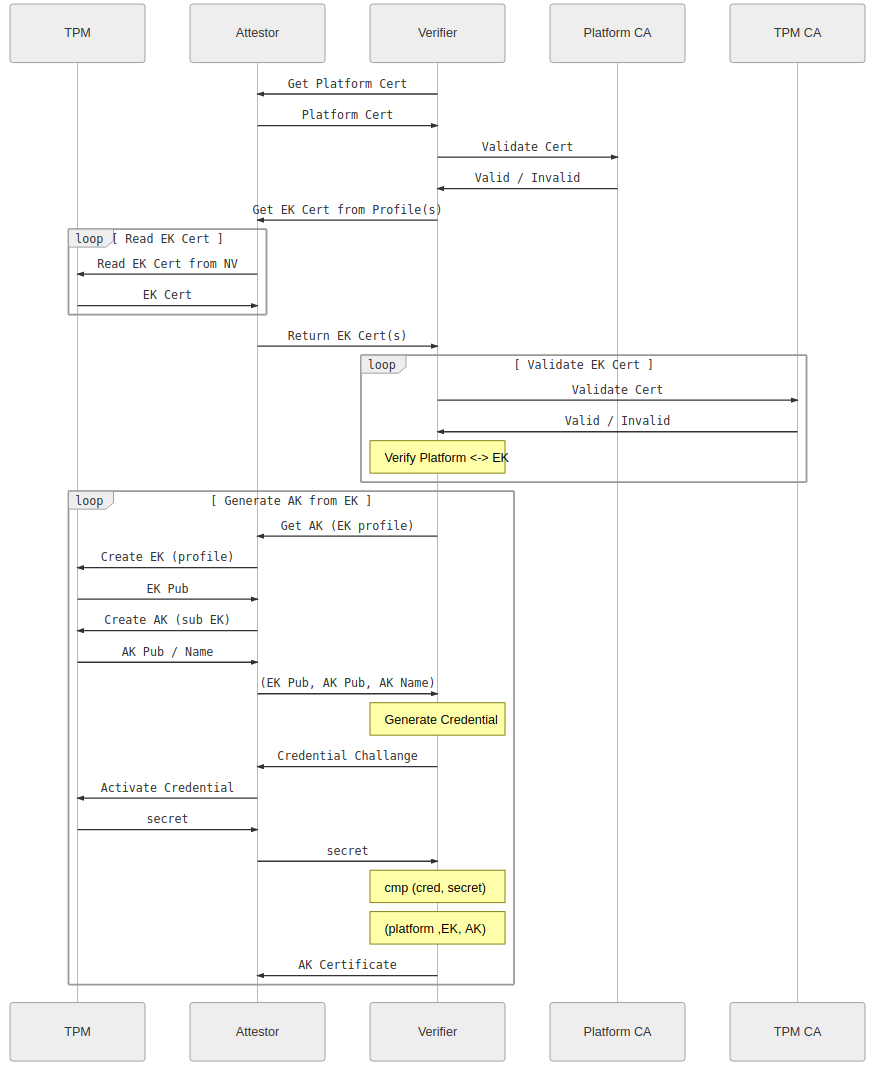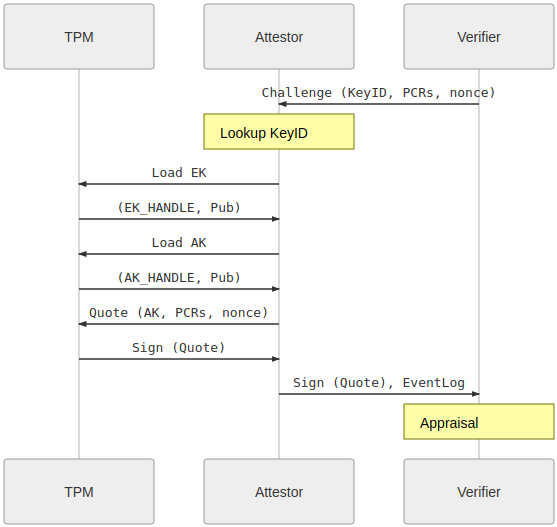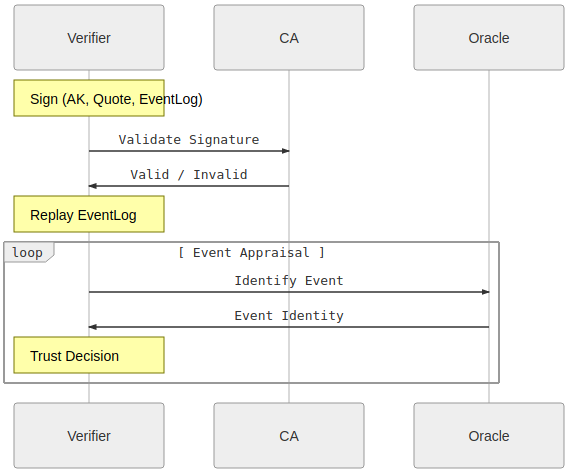TPM Remote Attestation protocol using go-tpm and gRPC
2021-08-18This repo contains a sample gRPC client server application that uses a Trusted Platform Module for:
- TPM Remote Attestation
- TPM Quote-Verify
- Sealed and PCR bound Transfer of RSA or AES keys.
- Parse TPM EventLog
Attestation:
( Images taken from Remote Attestation )

Quote/Verify:

EventLog

NOTE the code and procedure outlined here is NOT supported by google.
you’ll find the source here
Use this standalone to setup a gRPC client/server for remote attestation.
There are two parts:
-
attestor: agRPCserver which accepts connections from a verifier, performs remote attestation, quote/verify and then then securely receives a sealed key from a verifier. The key is distributed such that it can only get loaded or decoded on the attestor that has the TPM -
verifier: agRPCclient which connects to the corresponding attestor, and the attestor proves it owns a specific TPM. Once complete, the verifier will send a sealed RSA or AES Key that can only be decoded by that client.
As you can see, the whole protocol is rather complicated but hinges on being able to trust the initial Endorsement Key. As mentioned, this is normally done by validating that the EndorsementPublic certificate is infact real and signed by a 3rd party (eg, the manufacturer of the TPM). In the case of google’s shielded vTPM, it is signed by google’s subordinate CA and includes information about the VM’s instance_id value. This protocol also “validates” the PlatformCA which itself includes a reference (serial# reference) to the EndorsementKey. I suppose it can contain the hash of the EKcert as another attribute…
also see
Setup
We will use a GCP Shielded VM for these tests
First create two VMs
gcloud compute instances create attestor \
--zone=us-central1-a --machine-type=e2-medium --no-service-account --no-scopes \
--image=debian-11-bullseye-v20211105 --image-project=debian-cloud \
--shielded-secure-boot --shielded-vtpm --shielded-integrity-monitoring
gcloud compute instances create verifier \
--zone=us-central1-a --machine-type=e2-medium --no-service-account --no-scopes \
--image=debian-11-bullseye-v20211105 --image-project=debian-cloud \
--shielded-secure-boot --shielded-vtpm --shielded-integrity-monitoring
On each, install go 1.16+ and setup libtspi-dev, gcc (apt-get update && apt-get install gcc libtspi-dev)
apt-get update
apt-get install libtspi-dev wget gcc git -y
wget https://golang.org/dl/go1.17.linux-amd64.tar.gz
rm -rf /usr/local/go && tar -C /usr/local -xzf go1.17.linux-amd64.tar.gz
export PATH=$PATH:/usr/local/go/bin/
on the verifier (which in this case is the client) VM, edit /etc/hosts
and set the value of verify.esodemoapp2.com to the IP of the client (in my case, its 10.128.0.58).
$ gcloud compute instances list --filter=name=attestor
NAME ZONE MACHINE_TYPE PREEMPTIBLE INTERNAL_IP EXTERNAL_IP STATUS
attestor us-central1-a e2-medium 10.128.0.14 104.197.204.181 RUNNING
root@verifier:# hostname
verifier
root@verifier:# more /etc/hosts
10.128.0.14 attestor.esodemoapp2.com
ofcourse you can use any hostname here but the certificated provided in this repo matches the SAN values for TLS.
Tests
Now test the client-server by transmitting both an RSA and AES key.
On startup, the verifier will:
- Verifier contacts the Attestor
- Attestor returns EKCert (EK)
- Verifier checks Issuer of EKCert
Begin Remote Attestation
- Verifier Requests Attestation Key (AK). Attestor return AK
- Verifier uses (EK,AK) to begin Remote Attestation (MakeCredential) which involves using AK,EK to encrypt a value that it sends to Attestor
- Attestor decodes the secret sent by Verifier (ActivateCredential) and returns the decrypted value to Verifier
- Verifier confirms the secret sent matches. Verifier associates AK with EK
End Remote Attestation
Begin Quote/Verify
- Verifier Requests Quote over PCR values
- Attestor generates Quote over PCR value and uses AK to sign
- Attestor generates EventLog
- Attestor returns Quote and EventLog to Verifier
- Verifier checks signature of the Attestation is by the AK and the PCR values from the Quote. Verifier replays the eventLog to confirm derived PCR value.
- Verifier uses CA private key to sign an x509 certificate tied to the AK. The verifier could return this x509 back to the attestor over a new (unimplemented) gRPC API call.
End Quote/Verify
Begin Sealed Transfer (PushSecret)
- Verifier uses EK to encrypt either a local RSA or AES Key
- Verifier transmits encrypted Key to Attestor
- Attestor either decrypts the AES key or imports the External RSA key into its TPM
- Attestor generates a test signature using the RSA key or calculates the Hash value of AES key.
- Attestor returns the signature or hash to Verifier.
- Verifier confirms the signature value or hash (thereby confirming the Attestor decoded the RSA or AES key)
End Sealed Transfer
Begin Unrestricted SigningKey Transfer (PullSecret)
- Verifier Requests Unrestricted Signing Key
- Attestor generates RSA Key on TPM as a child of EK
- Attestor uses AK to Certify the new key
- Attestor transmits the TPM Wire firmat of the RSA key and test signature over some preshared data.
- Verifier uses AK to confirm the authenticity of the Certification and RSA Public key is attested.
- Verifier uses RSA Public key to verify the signature provided over preshared data
- Verifier extracts the public key from the TPM Wireformat and compares it with the Key embedded in the attestation
- Verifier uses the TPM Wire format Public key to verify the specifications for the unrestricted key (e,g matches template)
- Verifier uses CA private key to sign an x509certificate tied to the SigningKey. The verifier could return this x509 back to the attestor over a new (unimplemented) gRPC API call. The attestor could use this x509 and private key on its TPM to create an mTLS connection. See crypto.Signer for TPM and mTLS with TPM bound private key
End Unrestricted SigningKey Transfer
AES
Attestor AES
git clone https://github.com/salrashid123/go_tpm_remote_attestation.git
cd go_tpm_remote_attestation
go run src/grpc_attestor.go --grpcport :50051 \
--unsealPcrs=0,7 \
--caCertTLS certs/CA_crt.pem \
--servercert certs/attestor_crt.pem \
--serverkey certs/attestor_key.pem \
-useFullAttestation --readEventLog \
--platformCertFile certs/platform_cert.der \
--v=10 -alsologtostderr
Verifier AES
git clone https://github.com/salrashid123/go_tpm_remote_attestation.git
cd go_tpm_remote_attestation
# make sure /etc/hosts contains the internal ip for the attestor's vm set as "attestor.esodemoapp2.com" in /etc/hosts
go run src/grpc_verifier.go --importMode=AES --uid 369c327d-ad1f-401c-aa91-d9b0e69bft67 --readEventLog \
-aes256Key "G-KaPdSgUkXp2s5v8y/B?E(H+MbQeThW" \
--host attestor.esodemoapp2.com:50051 \
--expectedPCRMapSHA256 0:24af52a4f429b71a3184a6d64cddad17e54ea030e2aa6576bf3a5a3d8bd3328f,7:3d91599581f7a3a3a1bb7c7a55a7b8a50967be6506a5f47a9e89fef756fab07a \
--expectedPCRMapSHA1 0:0f2d3a2a1adaa479aeeca8f5df76aadc41b862ea \
--caCertTLS certs/CA_crt.pem --caCertIssuer certs/CA_crt.pem --caKeyIssuer certs/CA_key.pem --platformCA certs/CA_crt.pem \
--readEventLog \
--useFullAttestation \
--v=10 -alsologtostderr
RSA
Attestor RSA
go run src/grpc_attestor.go --grpcport :50051 \
--unsealPcrs=0,7 \
--caCertTLS certs/CA_crt.pem \
--servercert certs/attestor_crt.pem -useFullAttestation --readEventLog \
--serverkey certs/attestor_key.pem --platformCertFile certs/platform_cert.der \
--v=10 -alsologtostderr
Verifier RSA
go run src/grpc_verifier.go --importMode=RSA --uid 369c327d-ad1f-401c-aa91-d9b0e69bft67 \
--expectedPCRMapSHA256 0:24af52a4f429b71a3184a6d64cddad17e54ea030e2aa6576bf3a5a3d8bd3328f,7:3d91599581f7a3a3a1bb7c7a55a7b8a50967be6506a5f47a9e89fef756fab07a \
--expectedPCRMapSHA1 0:0f2d3a2a1adaa479aeeca8f5df76aadc41b862ea \
--rsaCert=certs/tpm_client.crt \
--readEventLog --useFullAttestation \
--caCertTLS certs/CA_crt.pem --caCertIssuer certs/CA_crt.pem --caKeyIssuer certs/CA_key.pem --platformCA certs/CA_crt.pem \
--rsaKey=certs/tpm_client.key --host attestor.esodemoapp2.com:50051 \
--v=10 -alsologtostderr
EventLog
Please see the following for background on the eventlog and how to use it
Note, on GCP Shielded VM, the default
PCR0value is:
# tpm2_pcrread sha1:0+sha256:0
sha1:
0 : 0x0F2D3A2A1ADAA479AEECA8F5DF76AADC41B862EA
sha256:
0 : 0x24AF52A4F429B71A3184A6D64CDDAD17E54EA030E2AA6576BF3A5A3D8BD3328F
You can find a full end-to-end trace for the AES example under the example/ folder
Platform Certificate
The platform certificate used in this protocol is just a sample, static one tied to a ShieldedVM’s EKCert serial number.
I did this because i do not know how to generate a platform cert in go. Instead i used NSA’s Platform Attribute Certificate Creator (paccor) in java to create the cert separately.
What this means is we just make believe/pretend that the platform cert is valid by statically comparing the serialnumbers. In reality the verifier should check the certificate serial number and that a valid privacy ca signed the cert..
Note a sample serial number that is in the EKCert
tpm2_nvread -o ekcert.der 0x01c00002
openssl x509 -in ekcert.der -inform DER -outform PEM -out ekcert.pem
# openssl x509 -in ekcert.der -inform DER -outform PEM -out ekcert.pem
openssl x509 -in ekcert.pem -text
Certificate:
Data:
Version: 3 (0x2)
Serial Number:
01:b0:01:fe:40:bf:96:77:47:51:a7:2e:9f:5d:e5:33:3d:6b:62
Signature Algorithm: sha256WithRSAEncryption
Issuer: C = US, ST = California, L = Mountain View, O = Google LLC, OU = Cloud, CN = "tpm_ek_v1_cloud_host-signer-0-2021-10-12T04:22:11-07:00 K:1, 3:nbvaGZFLcuc:0:18"
and the encoded reference of the same in the platform_cert.der
$ openssl asn1parse -inform DER -in certs/platform_cert.der
0:d=0 hl=4 l=1268 cons: SEQUENCE
4:d=1 hl=4 l= 988 cons: SEQUENCE
8:d=2 hl=2 l= 1 prim: INTEGER :01
11:d=2 hl=3 l= 218 cons: SEQUENCE
...
713:d=4 hl=2 l= 3 prim: OBJECT :X509v3 Authority Key Identifier
718:d=4 hl=2 l= 113 prim: OCTET STRING [HEX DUMP]:306F8014B7BAB002A1E7BE34C6C1055C6678E5BB535DA154A154A4523050310B3009060355040613025553310F300D060355040A0C06476F6F676C6531133011060355040B0C0A456E7465727072697365311B301906035504030C12456E746572707269736520526F6F74204341820102
833:d=3 hl=2 l= 65 cons: SEQUENCE
835:d=4 hl=2 l= 3 prim: OBJECT :X509v3 Certificate Policies
840:d=4 hl=2 l= 58 prim: OCTET STRING [HEX DUMP]:3038303606022A033030302E06082B0601050507020230220C20544347205472757374656420506C6174666F726D20456E646F7273656D656E74
900:d=3 hl=2 l= 94 cons: SEQUENCE
902:d=4 hl=2 l= 3 prim: OBJECT :X509v3 Subject Alternative Name
907:d=4 hl=2 l= 87 prim: OCTET STRING [HEX DUMP]:3055A45330513119301706066781050501040C0D4E6F74205370656369666965643119301706066781050501010C0D4E6F74205370656369666965643119301706066781050501050C0D4E6F7420537065636966696564
This links the platform cert with that specific EKCert
You can verify the Platform cert was signed by a given CA by using go-attestation.attributecert.AttributeCertificate.CheckSignatureFrom
3.2 Platform Certificate
This section contains the format for a Platform Certificate conforming to version 1.0 of this specification.
The Platform Certificate makes the assertions listed in section 2.1.6. This certificate format
adheres to RFC 5755 [11] and all requirements and limitations from that specification apply unless otherwise noted.
Applications
This is just an academic exercise (so do not use the code as is). However, some applications of this
- TPM based Google Service Account Credentials
- TPM based mTLS
- Trusted Platform Module (TPM) recipes with tpm2_tools and go-tpm
Ubuntu with AMD-SEV (–confidential-compute)
If you use a GCP Confidential Compute VM for the attestor, use the pcr values it currently holds
gcloud compute instances create attestor-cc --zone=us-central1-a --machine-type=n2d-standard-2 \
--confidential-compute --maintenance-policy=TERMINATE \
--image=ubuntu-2004-focal-v20210927 --image-project=confidential-vm-images \
--no-service-account --no-scopes \
--shielded-secure-boot --shielded-vtpm --shielded-integrity-monitoring
tpm2_pcrread sha1:0,7+sha256:0,7
sha1:
0 : 0xC032C3B51DBB6F96B047421512FD4B4DFDE496F3
7 : 0x45B6A836BDC555783626C9E4E6234AC692F76B0B
sha256:
0 : 0x0F35C214608D93C7A6E68AE7359B4A8BE5A0E99EEA9107ECE427C4DEA4E439CF
7 : 0xDD0276B3BF0E30531A575A1CB5A02171EA0AD0F164D51E81F4CD0AB0BD5BAADD
go run src/grpc_verifier.go --importMode=RSA --uid 369c327d-ad1f-401c-aa91-d9b0e69bft67 \
--expectedPCRMapSHA256 0:0f35c214608d93c7a6e68ae7359b4a8be5a0e99eea9107ece427c4dea4e439cf,7:dd0276b3bf0e30531a575a1cb5a02171ea0ad0f164d51e81f4cd0ab0bd5baadd \
--expectedPCRMapSHA1 0:c032c3b51dbb6f96b047421512fd4b4dfde496f3 \
--rsaCert=certs/tpm_client.crt \
--readEventLog --useFullAttestation \
--caCertTLS certs/CA_crt.pem --caCertIssuer certs/CA_crt.pem --caKeyIssuer certs/CA_key.pem \
--rsaKey=certs/tpm_client.key --host verify.esodemoapp2.com:50051 \
--v=10 -alsologtostderr
This site supports webmentions. Send me a mention via this form.